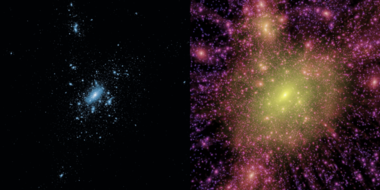Question
What would the universe look like if there was no gravity?
Asked By
Peik Bjarnason
Answer
The universe without gravity would be a very different place, and possibly even couldn’t exist at all! First, we need to think about what gravity is, and the various ways that it is described by scientists. Perhaps the simplest description of gravity is as a force that pulls stuff together. Any two physical objects — a football, a car, the Sun, a human being — will attract one another in the same way that the south pole of a magnet attracts the north pole of another magnet. The strength of the pull is related to how much stuff there is in each object, and how far apart the two objects are: the pull is stronger if objects are close together and also stronger if they contain a lot of stuff. You may be surprised to realise just how weak gravity is: an entire planet’s worth of rock is needed to hold you to the ground, whereas one small magnet can lift a nail up off the floor despite gravity trying to pull it down! This description of gravity as a force pulling objects together is called Newtonian gravity — after Isaac Newton — and we will use this description for this article. There is also a second, much more complicated description called general relativity, which is needed to understand extreme phenomena such as black holes; I will mention the differences between Newtonian gravity and general relativity at the very end. Now that we have described Newtonian gravity, we can imagine what the Universe would like if gravity were not to exist. First, let’s pretend that in our current Universe — with gravity — we decide to switch off gravity completely. You could throw a ball into the air and ... it would keep going. It would be slowed down as it hits air molecules, but it would never come back because there is no force trying to pull it back. The same would be true for you if you were to jump into the air: you would sail off into the sky. Everything that is held together by gravity would slowly disintegrate. Planet Earth would come apart, and its former rocks and water would fly away from the Sun. The Sun could explode as there is no longer anything to balance the outward force of the nuclear engine in its core. The remains of the Sun would cease orbiting the centre of the Milky Way galaxy, with all the other, similarly disintegrating stars, slowly expanding outwards. The galaxies themselves, held in orbit around one another by the mysterious dark matter, which I describe using an image of a computer-simulated cluster of galaxies in Fig. 1, will also drift apart. In this scenario, the Universe would look completely dark, with no stars to illuminate it and blocks of rock and dust — those small enough to be held together by electrostatic forces alone — travelling endlessly across space.- Figure 1: Simulaton credit: Y. Bahé, D. Barnes et al. (DOI: 10.1093/mnras/ stx1403, DOI: 10.1093/mnras/stx1647). Image credit: M. Lovell.
Um þessa spurningu
Dagsetning
Published 1.10.2021
Category:
Keywords
Citation
Mark Lovell. „What would the universe look like if there was no gravity?“. The Icelandic Web of Science 1.10.2021. http://why.is/svar.php?id=82486. (Skoðað 14.12.2025).
Author
Mark Lovellpostdoctoral researcher, University of Iceland




